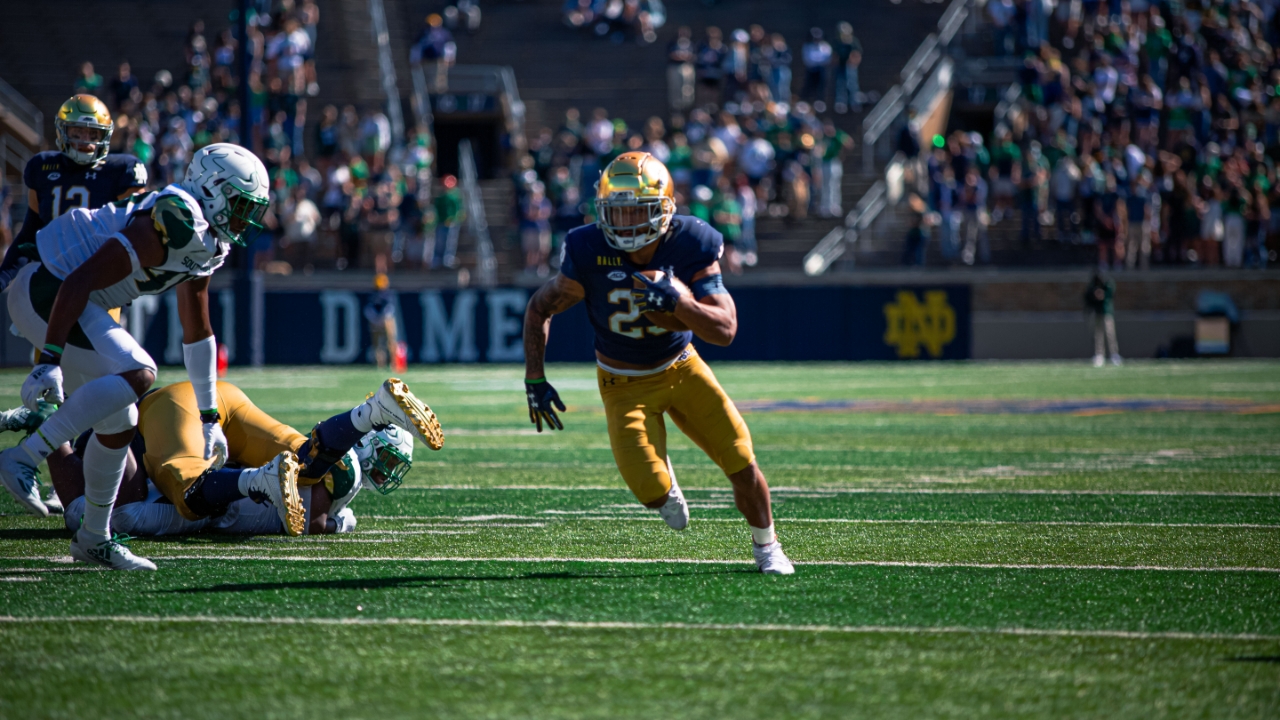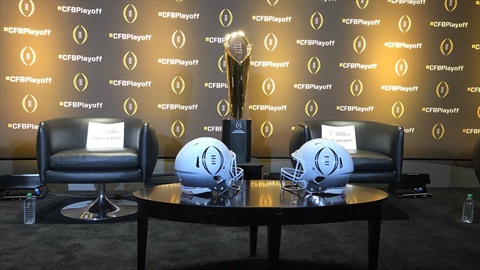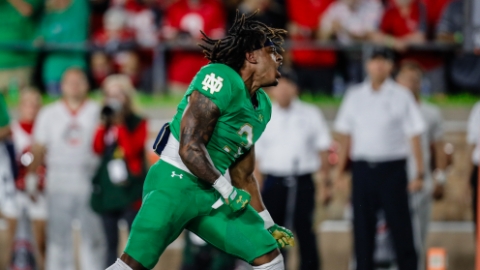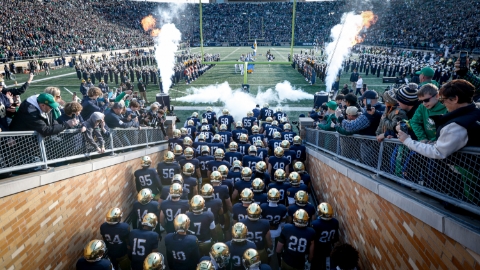
Notre Dame rushed for 281 yards against South Florida for an average of 6.2 yards per carry. That number would have easily eclipsed 300 total yards if not for great field position. The average start to a drive for them was their own 44 yard line.
A big talking point in the offseason was Notre Dame’s ability to use multiple tight ends because of the stockpile of talent they have there. This game they put those tight ends to work with mostly two and three tight ends on the field. They even went to four tight ends at the goal line with Tommy Tremble lined up as a fullback in the backfield.
What offensive coordinator Tommy Rees did with his play-calling and formations was notable. He came out of the gate with heavy formations, but threw the ball on the first three plays of the game. The offense eventually settled in with 12 and 13 personnel and proceeded to run the ball seemingly at will against USF’s defense.
It won’t look this easy against better competition, but there is definitely much to be learned from what Notre Dame did and how well they did it against USF. It all makes for a fun edition of Film Don’t Lie.
Constriction creates explosion
It starts out with the very first play and Notre Dame with 13 personnel (one back, three tight ends) on the field. This is the opposite of spreading teams out. It’s two tight ends in-line, Tremble (24) in as an H-back on the left side, and Javon McKinley (88) coming in motion tight to the formation.
This screams run to the defense, which is why play-action works so well here. The safety who has Tremble in man has eyes completely on the backfield and with McKinley running a vertical route to clear out, Tremble has plenty of room after running a corner.
Nothing about what you see from the personnel would make anyone suspect a big play in the passing game is coming and using 13 personnel the previous week would suggest this is going to be a run. It catches USF off guard and the game gets off to a great start for Notre Dame.
Ian Book ws 6 of 6 for 91 yards off of play-action in this game.
Numbers game
Here’s 13 personnel with the same formation and McKinley coming in motion again. This time he comes back right outside of Tremble as an extra blocker on 3rd and 3.
All this is Notre Dame outnumbering USF on the play side. As soon as McKinley comes in and blocks the safety, they only possible way for USF to get a stop before Kyren Williams (23) converts is to have the deep safety scream down like freight train from deep or have the corner, who had McKinley in man coverage, crash down from the outside.
This is where that first play of the game becomes a factor. Because they hit the big play out of this same look, it’s something that makes that corner and safety worry about McKinley or Tremble leaking out for a pass out of play-action. If they hesitate for a second, it’s enough for this to be easily converted.
Without those two players making a play, it’s just straight up man on man blocking with Robert Hainsey (72) and Brock Wright (89) absolutely caving down the defensive lineman. Tremble does a fantastic job of getting his hips around to seal off the edge defender and that leaves a big hole for Williams to run through to move the sticks.
Outside zone
Brian Kelly has said this is the bread and butter running play for their offense and they improved immensely running it this week compared to the previous one. The level of execution up front and by the backs was at another level.
Look at the line working together here. Look at how they all step together like it’s choreography. This is heaven for an offensive line coach to see the cohesiveness here.
The key to this play is Jarrett Patterson (55), Tommy Kraemer (78), and Hainsey working as a team. Patterson just gets a small piece of the nose tackle before he gets out to the linebacker. Kraemer is unable to reach the nose guard, but he drives through his shoulder and opens up a big hole for Williams to cut into. Hainsey is able to get inside of the end and that makes a lane for Williams to run through.
Zone blocking is all about creating lanes and having a back with the patience and vision to take advantage of it. Williams does exactly that with a great cut back and then finishes the run with great pad level against the safety’s cut tackle attempt.
Numbers part two
Here we are with 13 personnel again with McKinley coming in motion tight to Tremble. Look at how deep the corner and safety are. I don’t know if it was the early play-action or how much down and distance plays into it, but that’s a lot of cushion when you consider the formation.
Notre Dame has numbers there. The only unblocked guy is going to be the safety who is six yards off the ball. Wright and Hainsey absolutely wreck the guys across from them. This looks like the kind of blocker Wright was supposed to be.
Tremble bullies the linebacker and McKinley does a good job on the corner. That leaves the safety for C’Bo Flemister (20) who explodes with his cut and leaves that safety hugging air.
There is nothing fancy about this. Teams have to be aggressive to stop Notre Dame’s run game with three tight ends on the field. Through two games the Irish have rushed eight times for 50 yards (6.25 yards per carry) out of 13 personnel.
But if they are too aggressive, they risk getting burned by play-action like they did on the first play of the game.
Constriction counter
This is a tight bunch to the right and all of those runs to the overload side where Notre Dame did have USF outnumbered are what help make this counter successful. Kraemer is pulling and Tremble is following him making this similar to a counter trey.
The edge defender plays this soft and that makes this difficult to deal with for Kraemer. The edge looks like he is about to “wrong arm” this, but quickly jumps outside. Sometimes that ends up blowing up the play, but Tremble does such a great job of chipping him and then moving on to the linebacker.
I can’t say enough how great this was by Tremble. He was developing into an asset as a blocker last season and now he’s a full on weapon.
Avery Davis (3) is the receiver on the line of scrimmage from the bunch and is supposed to be picking up the safety. The ref is in the way of Davis’ angle and that prevents him from making the block.
It doesn’t matter, though, because Williams makes a subtle cut that is a thing of beauty to avoid the safety. And because Tremble sticks with the linebacker all the way through 10-yards down the field, Williams can cut back outside again to gain five extra yards.
Bonus play: USF’s one big run
I wanted to make this mostly about Notre Dame’s running game, but with USF only having one big play in this game, I thought it would be worth it to talk about why that play happened.
Yes, the back, Johnny Ford, making Shaun Crawford (20) miss was a big piece of it. That was a nasty cut and Crawford blew a tire trying to adjust to it.
But the main key to the play was the influence of the counter trey action the opposite direction. The left tackle and guard are pulling to the right and what that does is freeze Ade Ogundeji (91) from going up the field because he is thinking more about the possibility of a boot. That is why he is shuffling down the line.
Jack Kiser (24) bites on this hard when he sees the pull and Drew White (40) shuffle steps with it as well, but quickly recognizes that the ball is going the other way. Not quick enough, though. That one shuffle is enough to not get there to make the tackle on Ford after the receiver gets a piece of him.
Jeremiah Owusu-Koramoah (6) can see it happening, but it’s his job to get up the field and potentially fight outside of the tight end if Ford goes outside. The tight end does his job by widening that gap and that leaves Crawford to fill the alley, but Ford has enough room to cut it back on him. Then it’s just speed that takes over and it’s a 42-yard gain.
They tried this same play a couple of more times and one was called back for a holding call and another was blown up by the Irish for a loss. It’s usually a one time type of thing in a game so I’m surprised they went back to it. Then again, nothing else was working so Charlie Weis Jr. probably thought he didn’t have much choice but to give it a shot.



